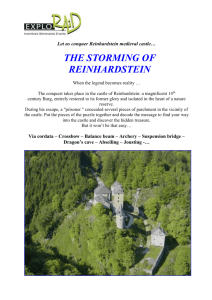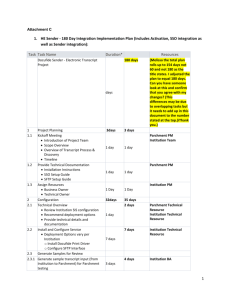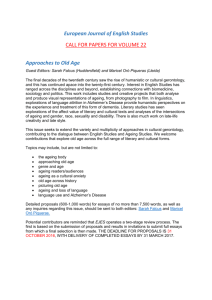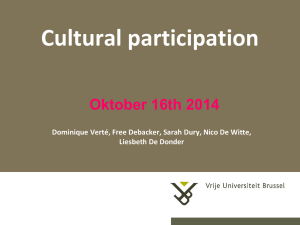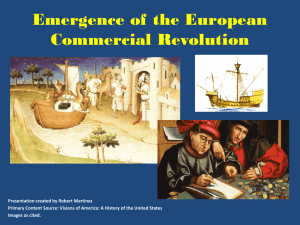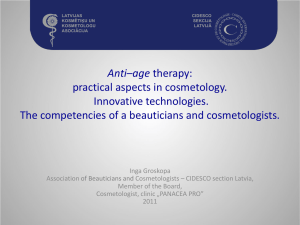Changes in Some Properties of Aged and Historical Parchment
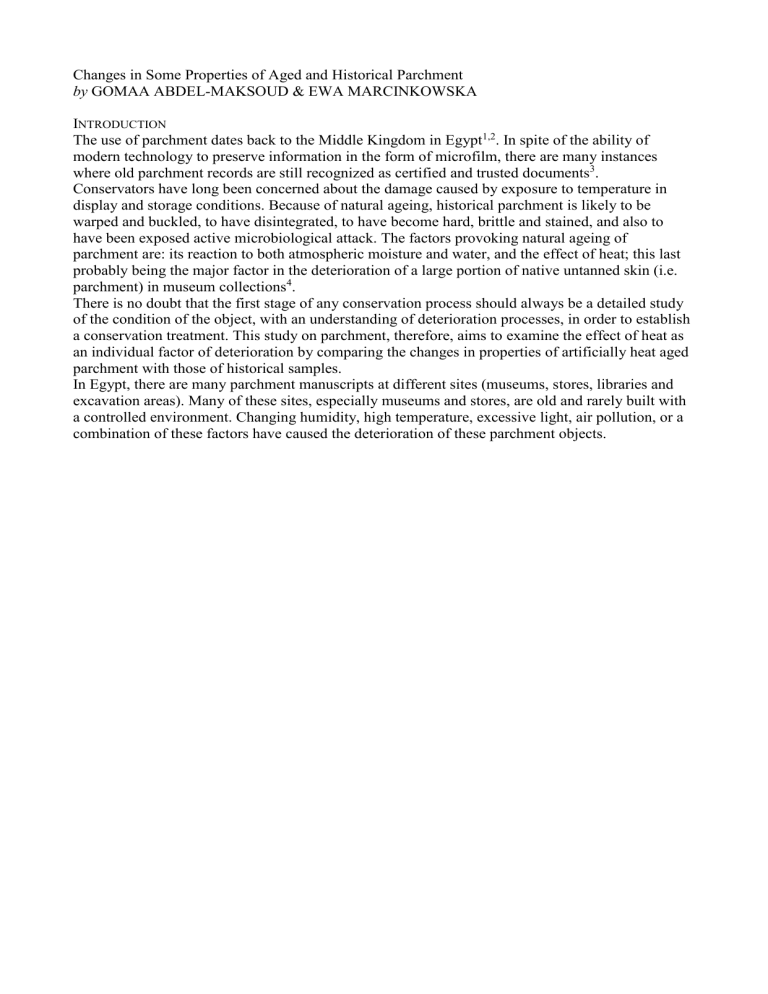
Changes in Some Properties of Aged and Historical Parchment by GOMAA ABDEL-MAKSOUD & EWA MARCINKOWSKA
I
NTRODUCTION
The use of parchment dates back to the Middle Kingdom in Egypt
1,2
. In spite of the ability of modern technology to preserve information in the form of microfilm, there are many instances where old parchment records are still recognized as certified and trusted documents
3
.
Conservators have long been concerned about the damage caused by exposure to temperature in display and storage conditions. Because of natural ageing, historical parchment is likely to be warped and buckled, to have disintegrated, to have become hard, brittle and stained, and also to have been exposed active microbiological attack. The factors provoking natural ageing of parchment are: its reaction to both atmospheric moisture and water, and the effect of heat; this last probably being the major factor in the deterioration of a large portion of native untanned skin (i.e. parchment) in museum collections
4
.
There is no doubt that the first stage of any conservation process should always be a detailed study of the condition of the object, with an understanding of deterioration processes, in order to establish a conservation treatment. This study on parchment, therefore, aims to examine the effect of heat as an individual factor of deterioration by comparing the changes in properties of artificially heat aged parchment with those of historical samples.
In Egypt, there are many parchment manuscripts at different sites (museums, stores, libraries and excavation areas). Many of these sites, especially museums and stores, are old and rarely built with a controlled environment. Changing humidity, high temperature, excessive light, air pollution, or a combination of these factors have caused the deterioration of these parchment objects.
E XPERIMENTAL SAMPLES New samples
Modern parchment from goat was prepared by Abdel-Maksoud
5
acording to Reed
6
and Abdel-
Hamid 7 .
Historical samples
• Library of the Medical Faculty, Cairo University. Most of them date back to the time of Kolut
Pek (19 th century) and to the time of AH Basha Ibrahium (2O th century). The studied samples were taken from a parchment certificate.
• Tanta Excavation. Three parchment manuscripts in Hebrew, presenting the Pentateuch of the Old
Testament 18 th and 19 th , centuries. Jewish cemetery, Tanta city, Egypt.
• The Coptic Museum. This museum contains a library for parchment manuscripts. Some samples were taken from this library; written in black ink, most of them date back to the Coptic period in
Egypt (5 th
and 6 th
centuries).
A
CCELERATED AGEING
Heat treatment was used in the accelerated ageing process according to Larsen
8 and Chahine
70°C, 100°C and 134°C. The period of ageing was between one and four weeks.
9
at
S
HRINKAGE
Generally, one property of collagen fibres is that they exhibit a sudden shrinkage when heated. The shrinkage temperature of limed collagen ranges from 50°C to 60°C 10
. Degraded collagen fibres have a lower shrinkage temperature
11-13
. To prove this the shrinkage temperature was measured by using the micro-hot table technique and a polarizing microscope.
Preparation for shrinkage temperature measurement
Haines
14
noted that shrinkage temperature should be measured under controlled conditions, which include the need for the parchment samples to be thoroughly
wet in distilled water. This was achieved by using several changes of distilled water. It was felt that the changes of water would help to lessen any contamination, by salts for instance, influencing the pH. The samples were heated at a rate of 3°C per minute.
Measurement of shrinkage temperature
The procedure, according to Young 15 , for measuring the shrinkage temperature using the hot stage was followed. Once cut, the fibers, positioned between glass depression slides, were degreased in acetone for five minutes and then soaked in distilled water for approximately five to ten minutes.
After this procedure they were transferred using steel tweezers to a second bath of distilled water for a minimum of 45 minutes to allow full saturation, moved to a microscope slide prepared with a small reservoir of distilled water containing glycerine, which kept the fibers continually hydrated and unrestrained throughout the heating cycle. Each transfer, from acetone to water and water to slide, was performed quickly to ensure that the fibers did not dry out, as this would falsely lower the shrinkage temperature. The slide containing the fibers was inserted into the hot stage, which was placed onto the stage of the polarizing microscope. The shrinkage process was observed at magnification factor 100 using a polarizing light microscope.
Once the hot stage was activated and the shrinkage temperature range of the sample was reached the structural order within the fibers became disrupted. The fiber shrank and lost birefringence. This shrinkage and loss of birefringence continued as the temperature increased.
Measurements were performed on modern parchment after weeks 1, 2, 3 and 4 of heat ageing.
Additionally, measurements were made on the historical samples.
M
ECHANICAL PROPERTIES
Mechanical properties were measured according to ISO 3376
16
. Samples were taken from adjacent zones of a skin. These samples were 90 mm long, the free length between jaws of the testing machine was 50 mm, and the width of the free length was 10 mm. The average thickness of the new samples was 0.33 mm ± 0.02 mm. The average thickness of the historical samples was 0.43 mm ±
0.03 mm. Six samples were taken from the modern skins, three perpendicular to and three parallel to the backbone, and the three results averaged for each direction. Only
one sample could be taken from the historical parchments. The speed of stretching during measuring was 100 ± 20 mm/min. A Universal Testing Machine (Model 1435, producer: Zwick
(Ulm, Germany) was used for measuring. The samples were measured after conditioning for 48 hours at 20°C and 65 % RH according to ISO 554 17
. The tensile strength is found by dividing the breaking force (N) by the product of width and thickness of the samples (mm). The results are expressed as N per mm 2 . The elongation at break is given in %.
H UMIDITY SORPTION
Determination of moisture content was based on the weight loss of a sample dried by the action of infrared heating rays directed on the sample (heating from within), using a Mettler LP16 Infrared
Dryer. The instrument is mounted on a precision balance, which is connected to a computer and printer so that complete records of the drying profiles and the final results can be produced. The temperature during this process is 105°C. Water molecules strongly absorb infrared radiation, which result in the rapid evaporation of the water. Before the procedure of drying, the samples were placed for five days in top of a desiccator, which was filled with saturated solution of di-sodium hydrogen orthophosphate (Na
2
HPO
4
• 12 H
2
O) to create a relative humidity of 95%. The temperature was 20°C.
C HANGE OF COLOUR
Colour changes caused by heat were measured using the CIE*Lab system, commonly used to compare the colours of two samples. The L scale measures lightness, and varies from 0 (black) to
100 (perfect white). The a-scale measures red-green; -fa means more red, -a means more green. The b-scale measures yellow-blue, +b meaning more yellow, -b more blue. Differences in colour between two specimens are determined by the use of the Greek letter Delta (ΔL, Δa, Δb); the total colour difference (ΔE) is found according to the following equation 18
:
The measurement was made using a Shimadzu Double Beam UV-2101 PC Spec-trophotometer equipped with ISR 48 Integrating Sphere.
Fig. 1: Effect of accelerated heat ageing at different temperatures on the shrinkage temperature of modern parchment. ○ 70°C - □ 100°C - Δ 134°C.
Fig. 2: Shrinkage temperature of historical parchment of different age: ◊ Samples of the Medical
Library - + Samples of Tanta Excavation – җ Samples of the Coptic Museum.
Fig. 3: Microscopical pictures of modern parchment after accelerated ageing at room temperature
(left column) and at shrinkage temperature (right column). 1,2: ageing at 70° C; 3,4: ageing at
100°C; 5,6: ageing at 134°C.
R
ESULTS
Generally, parchment appears to tolerate temperatures of 130°C for periods of at least a few weeks.
At higher temperatures modern parchment begins to curl at the edges and becomes slightly darker in colour. Reed
6
reported that all parchment at a temperature range of between 130°C-150°C, generally shrinks in all dimensions and curls into a roll which, on removal from the oven, is extremely hard and brittle and proves to be impossible of being reconditioned to its former state.
Shrinkage
The results proved that heat ageing affected the collagen of the parchment, which is clearly reflected in the shrinkage temperature, considering that parchment of the control sample (before ageing) presents a shrinkage temperature of 54°C The reduction in shrinkage temperature of aged modern parchment (Fig 1 and 3) after 4 weeks at 70°C was 13 %, at 100°C 17 % and at 134°C 28
%. From the data (Fig. 2 and 4) it becomes clear that the reduction in the shrinkage temperature of historical parchments compared with the control sample differs from place to place. The final results also show that all the historical parchments have suffered from degradation, more so than those which were artificially aged The reduction of the shrinkage temperature of the historical parchments by comparison with modern parchment (before ageing) was as follows:
• Certificate from the Faculty of Medicine Library (Cairo University), sample 1 and 3: 29 %.
• Certificate from the Faculty of Medicine Library (Cairo University), sample 2:
• Manuscripts from Tanta excavation, sample 1: 35
%.
• Manuscripts from Tanta excavation, sample 2: 33 %.
• Manuscripts from Tanta excavation, sample 3:33 %.
• Manuscripts from Coptic Museum, sample 1: 38 %.
• Manuscripts from Coptic Museum, sample 2:36 %.
• Manuscripts from Coptic Museum, sample 3: 35 %.
M
ECHANICAL PROPERTIES
It becomes clear from Fig. 5 and 6 that there is a significant reduction in mechanical properties
(tensile strength and elongation) for both aged and historical samples in perpendicular and parallel directions as compared with samples before ageing. The percentage loss of tensile strength after four weeks is:
• at 70°C in perpendicular direction: 29 %; in parallel direction 60 %;
• at 100°C in perpendicular direction: 51 %; in parallel direction 70 %;
• at 134°C in perpendicular direction: 88 %; in parallel direction 87 %. The percentage loss of elongation after four weeks is:
• at 70°C in perpendicular direction: 72 %; in parallel direction 37 %;
• at 100°C in perpendicular direction: 62 %; in parallel direction 59 %;
• at 134°C in perpendicular direction: 92 °/o, in parallel direction 93 %.
The effect of heat on tensile strength at 70°C and 100°C after one week is quite different in the perpendicular and in the parallel directions, but, as can be seen from Fig. 5, after two and after four weeks these differences almost disappear. At 134°C there are already no differences after one week.
The historical samples (Table 1) show significantly lower tensile strength and elongation. The reduction in mechanical properties is due to the decrease in distance between the polypeptide chains, resulting in the strengthening of crosslinks and the eventual deformation of the gross structure. The increased proximity of the chains is initiated by the loss of water. Water molecules no longer form bridges between adjacent chains, or natural plasticizers, such as small amounts of grease and fatty substances, may be removed or decay.
H UMIDITY SORPTION
From Fig. 7 it can bee seen that humidity sorption of new parchment at 95 % RH, and 20°C is quite high, and that it decreases with an increase in temperature during ageing. Larsen
19
proved that the total humidity sorption curve decreases with
Fig. 6: Effect of accelerated heat ageing at different temperatures on the elongation at break of modern parchment.
Fig. 6: Effect of accelerated heat ageing at different temperatures on the elongation at break of modern parchment.
Fig. 7: Determination of humidity sorption at 95 % RH, 20°C of modern parchment before and after accelerated ageing at: O 70°C - □ 100°C - Δ 134°C.
Fig. 8: Determination of humidity sorption at 95 % RH, 20°C of historical parchment. ◊ Samples of the Medical Library - + Samples of Tanta Excavation – җ Samples of the Coptic Museum.
increasing deterioration. In our case the loss percentage after 25 days was 52% at 70°C, 62 % at
100°C and 74 % at 134°C. Fig. 8 shows that the humidity sorption of historical samples is distinctly lower, i.e. on a level that is reached for modern parchment after longer accelerated ageing at high temperature only. It was noted that relatively high sorption of moisture was obtained from parchment manuscripts from Tanta Excavation and low sorption of moisture was obtained from parchment manuscripts from Coptic Museum. Hallebeek 20 proved that for artificially aged samples there is a general tendency for the amount of total moisture to fall when the samples are more degraded, but that for natural (historical) samples the percentage of total moisture content is higher when the degree of degradation is higher. An explanation for the deterioration mechanism of water absorption of artificial aged and historical parchment could be as follows: water is present in parchment in three forms, free, associated and bound. The occurrence of bound water acts as protection against denaturation, whereas associated and free water are reserve sources
20, 21
. Bound water is held by strong chemical bond in polar groups in the protein molecules, while free water is held by capillary forces. The amount of free water, depend on the formative structure of the parchment fibres and the porosity of membrane. The force, which coheres bound water with protein molecule is much greater than the force which coheres free water with walls of capillary pores in parchment. This indicates that the ability of parchment to lose free water is much greater than its ability to lose bound water. Therefore, it can be said that the amount of free water depends on humidity, and the variation in free water content depends on environmental conditions. The amount of bound water depends on the chemical and physical properties of the protein molecule. The parchment continues to retain bound water if it is not exposed to dryness or high temperature. The loss of free water in parchment results in a loss of softness, while the loss of bound water results in its deterioration, due to changes that occur in its chemical structure and physical properties. In our study we found that the ability of new parchment to absorb humidity was about 50% higher than that of historical parchment, while the decrease during accelerated ageing was 52%, 62 % and 74
%, depending on the ageing temperature (cf. Fig. 7).
C HANGE OF COLOUR
Colour by definition has three dimensions. The first is known as reflectance, also defined as value of lightness. The second dimension of colour is known as hue. Hue is the attribute of colour that distinguishes green from red and blue from yellow. The third dimension of colour is saturation of chrome.
Table 2: Change of colour parameters of modern parchment after accelerated ageing at different temperatures.
The colour we see ranges from violet (400 to 430 nm), blue (430 to 458 nm), green (485 to 570 nm), yellow (570 to 585 nm), orange (585 to 610 nm), to red (above 610 nm). This range comprises what is known as the visible spectrum. Qualitatively, the nature of a colour change can be understood by examining the visible reflectance spectrum before and after the sample has been exposed to artificial heat ageing. The colour change is indicated by the change in the spectrum
22
.
From colour measurement data (Fig. 9) it becomes clear that the values of the brightness (value L) decreased with an increase in temperature during ageing. The reduction of the brightness after four weeks of ageing in relation to the brightness before ageing was 6 % at 70°C, 17 % at 100°C and 21
% at 134°C (cf. Table 2). At 70°C and 100°C the decrease was slow during the first two or three weeks, while at 134°C the reduction increased continuously during the whole period of ageing. All historical samples are significantly darker than the modern ones even after the longest period of ageing at the highest temperature. The a-value increased with increasing temperature during the course of ageing, indicating that the colour of the samples is changing towards red during ageing.
Regarding the historical samples, the a-values of the Tanta excavation samples are as high and even higher than the a-values of modern parchment after a
Fig. 9: Change of colour parameters of modern parchment during accelerated ageing at different temperatures: O 70°C - □ 100°C - Δ 134°C.
Fig. 10: Colour parameters of historical parchments. ◊ Samples of the Medical Library - + Samples of Tanta Excavation - җ
Samples of the Coptic Museum.
longer period of ageing at the highest temperature. During the two or three centuries of their history these parchment samples must have suffered very aggressive conditions, comparable to the harshness of longer accelerated ageing at high temperatures.
The yellow colour (value b) also increased with increasing temperature during ageing, but not as much as the a-value. Accelerated ageing seems to provoke reddening of parchment more than a yellowing. Most striking is the fact that the b-value of the historical parchment samples has not increased with their age. One of the oldest samples (Coptic Museum no.l) is significantly less yellow than any of the modern samples even before ageing.
D
ISCUSSION
Measurement of shrinkage temperature of heat aged and historical parchment shows that there is a clear connection between the shrinkage temperature and the chemical changes in the studied samples due to deterioration. In the historical samples, used for this study, shrinkage takes place at a much lower temperature, in one of the Coptic Museum samples close to 33°C.
From the physical point of view, the most important characteristics of collagen are the way in which fibres swell in solutions and the way in which they shrink at a definite temperature. When collagen is denatured, i.e. when its helical structures, though not necessarily its components, are destroyed, it forms gelatin; a familiar substance, but unusual among proteins in so far as it has no internal ordered structure.
An explanation for the shrinkage temperature process, according to Southward
23
, is as follows; collagen stability is largely dependent on the highly ordered, semi-crystalline structure of the fibril, which is stabilized predominantly by intramolecular hydrogen bonds between peptides of the triple helical collagen molecule. Loss of stability can occur in the following manner.
When a collagen sample is in an aqueous medium, water easily penetrates the collagen molecule due to its affinity for the hydrogen bonding sites in the amorphous areas. The presence of water increases the spacing between the collagen chains. Macroscopically, this effect is seen as a swelling of the sample in question. If the sample is then heated at a certain temperature, the thermal energy will become sufficient to break the hydrogen bonds in the amorphous areas holding the polypeptide chains together, each individual chain then folds into random coils, and the hydrogen macromolecule loses its ordered structure and denatures. Collagen which has denatured has lost its partially crystalline nature, as can be evidenced under polarized light by a loss of birefringence.
On the basis of the study, it can be noted that the physical disintegration of both artificially and naturally aged parchment is caused by competition and interaction of the oxidative breakdown of collagen in limed parchment. The cause of the oxidative breakdown is mainly due to environmental factors, such as heat for artificially aged parchment, and several combined factors (heat, light etc) for historical parchment.
The shrinkage tempera ture of historical parchment samples is distinctly lower than that of the modern parchment samples, even after sharp accelerated ageing (134°C) over a longer period (4 weeks). We observed only little difference between die shrinkage temperature of the samples from the Tanta Excavation and the samples from the Coptic Museum, despite there being more than a
1000 years age difference between them. The main reason for this are the aggressive conditions of the excavation site compared to the environmental conditions in the museum collection. The effectiveness of the first conservation treatment, i.e. a temporary treatment in the excavation area, may also contribute. The lack of a report on the historical circumstances of the Tanta Excavation makes it impossible to take account of the conditions in which the parchment had lain buried and/or the conditions before and after arrival in the museum collection.
Some parts of the parchment are apparently less hydrothermally stable than others because of pertubation or deterioration of their crystalline and ordered amorphous structure. The less stable regions begin to shrink at lower temperatures, whereas the more stable regions denature at higher temperatures approaching more normal shrinkage temperature (T s
) values. A similar description applies for fibers. The total fibril deterioration in each fiber varies, and, therefore some fibers begin to shrink at a lower temperature than others. Larsen
19
has shown that the cause for loss in hydrothermal stability of the old historical samples can be ascribed to several combinations of the two main breakdown mechanisms. In general this is:
• Strong oxidation and strong acid hydrolysis,
• Strong oxidative and less hydrolysis,
• Strong acid hydrolysis and less oxidation.
Larsen
19
reports that the differences in the hydrothermal stability of fibres in a sample may be ascribed to three main factors:
• Differences in stability due to initial treatment of the skin;
• Non-uniformity in production;
• A non-uniform degree of deterioration.
It has been shown that the importance of the three reasons for differences may be arranged in the order 3 > 2 > 1.
These results have been confirmed by many authors. Chahine and Rottier
24 reported that when the structure of collagen is damaged by oxidative breakdown, there appear to be fewer and weaker hydrogen bonds maintaining the structure. Under these circumstances less thermal energy is needed to break the remaining hydrogen bonds and, therefore, fibre shrinkage occurs at a lower temperature. Larsen
25
proved that shrinkage temperature decreases during ageing.
C
ONCLUSIONS
• When modern parchment is heated, the fibres of collagen tolerate temperatures at 70° C and 100°
C for four weeks, but at 134° C the parchment breaks down into very small lengths which, under the further action of the same heat for a long time (more than four weeks), change into a complex material by the process of oxidation.
• Several properties of artificially heat aged modern parchment samples increase during ageing and as the temperature increases. For historical samples, these changes depend on many factors, and depend more on the condition of the surrounding environment than on the age of a sample.
• A study of moisture sorption characteristic of parchment is a useful indication of its relative state of degradation. The relationship between equilibrium moisture content and relative humidity would reveal more information than just the total water content. Modern parchment absorbs moisture more than both artificially heat aged and historical. The ability of modern parchment to absorb humidity is decreased with longer time and higher temperature of accelerated ageing. The ability of very old historical parchment to absorb humidity is better than that of modern parchment after heat ageing at high temperature (134° C) for less than two weeks. This is due to the structure and properties of historical samples.
• Another possible method of estimating the degree of degradation would be to measure shrinkage temperature. The hydrothermal stability of parchment is decreased as the time of ageing and temperature are increased. For historical samples the reduction depends on the condition of the object in archaeological sites.
• For microscopically observing shrinkage temperature, only minute samples of collagen fibres are required, which is a great advantage for research in historical parchments. Samples of only 0.1 to
0.5 mg are needed. Therefore, the measurement of hydrothermal stability using a polarizing microscope with the
hot table technique can be considered as being practically a non-destructive method.
Measurements of the shrinkage temperature of historical samples proved that the percentage loss of hydrothermal stability was high. This is a clear indication that all historical samples studied are in a bad condition, depending from their age: the lowest shrinkage temperature was found with the samples from the Coptic Museum (5 century), followed by the samples from the Tanta Excavation
(18 th century), while the shrinkage temperature of the samples from the Library of Faculty of
Medicine (19/20 th
century) was nearer to that of samples after prolonged accelerated ageing at very high temperature.
It is clear from this study that most archaeological sites in Egypt need to draw up a plan for monitoring the condition of parchment manuscripts.
A CKNOWLEDGEMENT
We would like to thank Mr. Waldemar Zuk for his help and suggestions.
S UMMARIES
Changes in Some Properties of Aged and Historical Parchment
The starting point for the research reported here is the poor state of parchment documents at many sites in Egypt: museums, stores, libraries and excavation areas. Modern parchment samples were submitted to accelerated ageing at different temperatures (70°, 100°, 134° C). Several properties
(shrinkage temperature, mechanical strength, humidity sorption, colour change) were measured and compared with the same properties of historical parchment samples from the 5 lh
, the 18/19 th
and the
20 th
centuries. The applied methods seem to be apt to determine the state of deterioration, which is considered the first step of conservation.
The shrinkage temperature was measured using the micro-hot table technique, which is considered to be a non-destructive method because only very small samples are needed for the measurements.
Modifications de certaines proprietes du parchemin ancien et historique
Le point de depart de 1'etude exposee ici se situe dans le triste etat des objets en parchemin tels qu'ils sont conserves dans beaucoup d'endroits en Egypte : dans les musees, les bibliotheques, sur les sites de fouilles archeologiques et chez les antiquaires. Des echantillons de parchemin moder-ne ont ete soumis au vieillissement accelere a differentes temperatures (70°, 100°, 134° C).
Certaines proprietes (temperature de contraction, resistance mecanique, absorption de l'eau, modification de la couleur) ont ete mesurees et comparees avec les proprietes correspondantes du parchemin historique du 5 eme , 18/19 eme et du 20 eme Siecle. Les methodes appliquees semble
etre adaptees pour evaluer 1'etat de deterioration du parchemin, ce qui constitue le premier pas vers la restauration. La temperature de contraction a ete mesuree selon la technique de la micro-platine chauffante. Cette methode peut etre considered comme non-destructive car elle ne re-quiert que de tres petits £chantillons pour effectuer les mesures.
Änderungen in einigen Eigenschaften von gealtertem und historischem Pergament
Der Ausgangspunkt für die Untersuchung, über die berichtet wird, ist der schlechte Zustand der
Objekte aus Pergament in vielen Aufbewahrungsorten in Ägypten, in Museen, Bibliotheken, an
Ausgrabungsstatten und bei Antiquitätenhändlern. Proben modernen Pergaments wurden einer beschleunigten Alterung bei verschiedenen Temperaturen (70°, 100°, 134° C) unterworfen. Bestimmte Eigenschaften (Schrumpfungstemperatur, mechanische Festigkeit, Wasseraufnahme,
Farbänderung) wurden gemessen und mit den entsprechenden Eigenschaften von historischem
Pergament aus dem 5., 18./19. und dem 20. Jahrhundert verglichen. Die gewählten Untersuchungen scheinen geeignet zu sein zur Bestimmung des Abbauzustands von Pergament, was als erster Schritt zur Konservierung gilt.
Die Schrumpfungstemperatur wurde auf einem Miniatur Heiztisch gemessen. Diese Methode kann als nicht maaterialzerstorend gelten, weil nur sehr kleine Proben dafür benötigt werden.
R EFERENCES
1. Shahine, A.A.: Conservation of some pieces of parchment and papyrus fiom the excavations of the Society of Egyptian Archaeology London. In Kasr Ibrim, Nubia, 1972. From Coptic Museum,
Master degree, Conservation Department, Faculty of Archaeology, Cairo University 1978.
2. Shahine, A.A.: Scientific principles for treatment, restoration and conservation of books, manuscripts and historical documents., Cairo: General Egyptian Book Organization 1990.
3. Forbes, R. J.: Leather in antiquity. Studies in Ancient Technology 5. Leiden: Brill 1957.
4. Williams, R. S.: Surface encrustation on caribou skin coat. Ottawa: Canadian Conservation
Institute 1982: 1-14.
5. Abdel-Maksoud: G. M. M.: Preparation of parchment samples for experimental studies in conservation. Journal of Cracow University oftechnology 1-A (1999): 154-167.
6. Reed, R.: Ancient skins parchments and leathers. London, New York: Seminar Press 1972: 118-
173.
7. Abdel-Hamid, H.: Scientific procedure for conservation of organic materials (manuscripts, woods and textiles). Cairo: Egyptian Book Organization 1984: 55.
8. Larsen, R.: Similarities and differences in the amino acid composition of new, historical and aged leather. Conservation - Restoration of Leather. Training of Restorers. 6th International Restorer Seminar, Veszprem 1987: 205-210.
9. Chahine, C, & C. Rottier: Study on the stability of leather treated with polyethylene glycol.
ICOM Committee for Conservation, Interim Meeting on the Treatment and Research into Leather, in Particular of Ethnographic Objects. Amsterdam, 5-8 April 1995: 77-85.
10. Sykes, R. L.: Leather, its composition and changes with time. London: The Leather
Conservation Center Printhouse 1991: 10.
11.
Young, G. S.: Shrinkage temperature. Interim report. In: Analytical Report. Ottawa:
Canadian Conservation Institute 1985: 1-20.
12. Young, G. S.: Shrinkage temperature. Halifax Interim Report 11, presented at the annual IIC-
CG Conference. Ottawa: Canadian Conservation Institute 1985: 1-13.
13. Nayudamma, Y.: Shrinkage temperature. The Chemistry and Technology of Leather 11. New
York: Krieger 1978: 29-42.
14. Haines, B. M.: Shrinkage temperature in collagen fibres. Leather Conservation News 3, 2
(1987): 1-5.
15. Young, G. S.: Microscopical hydrothermal stability measurements of skin and semi-tanned leather. Preprints. ICOM Committee for Conservation. 9th Triennial Meeting, Dresden 1990: 626-
631.
16. Leather - Determination of tensile strength and elongation. ISO 3376. International Standards
Organisation 1976.
17. Paper - Standard atmospheres for conditioning and/or testing - specifications. ISO 554.
International Standards Organisation 1976.
18. Billmeyer, F. W., & M. Saltzman: Principles of colour technology. New York: Wiley '1981.
19. Larsen, R., M. Vest, & K. Nielsen: Determination of hydrothermal stability (shrinkage temperature). STEP Leather Project. European Commission. Direction-General for Science,
Research and Development. Copenhagen: The Royal Danish Academy of Fine Arts, School of Conservation 1994: 151-160.
20. Hallebeek, P.B.: Moisture uptake/release and chemical analysis. STEP leather project.
European Commission, Decoration-General for Science, Research and Development. Copenhagen:
The Royal Danish Academy of Fine Arts, School of Conservation 1994: 107-111.
21. Dernovskova, J., H. Jirasova &J. Zelinger: 1995. An investigation of the hygroscopicity of parchment subjected to different treatments. Restaurator 16 (1995): 31-44.
22. Abdel-Mohsen, F.F., S.M. El-Borollosy & A.M. Fahmy: The effect of artificial daylight on the fading of Egyptian automotive paints. Dokki (Cairo): National Research Centre 1991.
23. Southward, J. A.: The effects ofphotodegradation on collagen: an analysis using the shrinkage temperature method. Theses. Master of Art Conservation, Queen's University, Kingston (Ontario)
1993: 6.
24. Chahine, C, & C. Rottier: Changes in thermal stability during artificial ageing with pollutants: a DSC study. Paper delivered at the Interim Symposium of die ICOM Conservation of Leathercraft and Related Objects Group, London: Victoria and Albert Museum, 1992, June 24-25: 6-7.
25. Larsen, R., M.Vest, D.V. Poulsen & U.B. Kejser: Determination of hydrothermal stability by the micro-hot table method. Environment Leather Project. Deterioration and Conservation of Vegetable Tanned Leather. Copenhagen: The Danish Academy of Fine Aets. School of Conservation
1997: 145-158.
Gomaa Abdel-Maksoud
Faculty of Archaeology, Department of Conservation,
Cairo University,
Cairo
Egypt
Ewa Marcinkowska
Department of Commodity Science
Cracow University of Economics
Sienkiewicza 4,
30 033 Krakow
Poland

